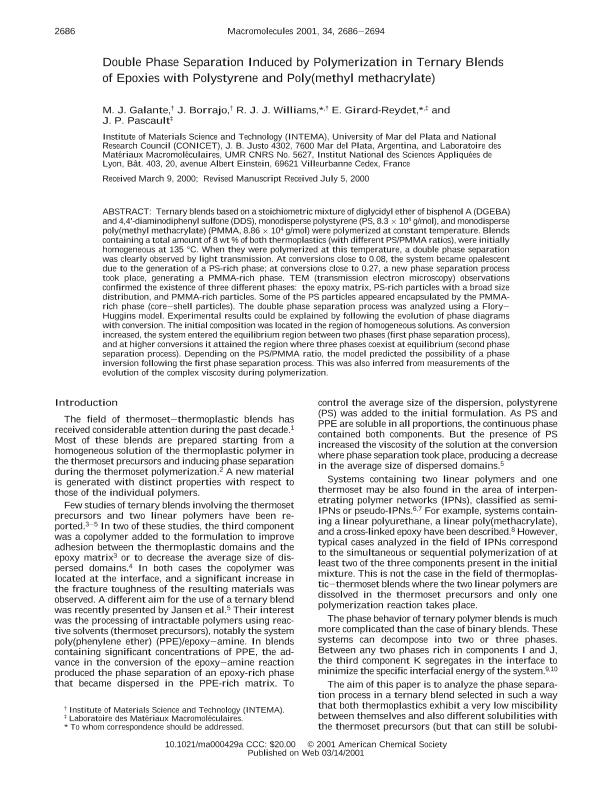Artículo
Double phase separation induced by polymerization in ternary blends of epoxies with polystyrene and poly(methyl methacrylate)
Galante, Maria Jose ; Borrajo Fernandez, Julio
; Borrajo Fernandez, Julio ; Williams, Roberto Juan Jose
; Williams, Roberto Juan Jose ; Girardt Reydet, E.; Pascault, J.P.
; Girardt Reydet, E.; Pascault, J.P.
 ; Borrajo Fernandez, Julio
; Borrajo Fernandez, Julio ; Williams, Roberto Juan Jose
; Williams, Roberto Juan Jose ; Girardt Reydet, E.; Pascault, J.P.
; Girardt Reydet, E.; Pascault, J.P.
Fecha de publicación:
04/2001
Editorial:
American Chemical Society
Revista:
Macromolecules
ISSN:
0024-9297
Idioma:
Inglés
Tipo de recurso:
Artículo publicado
Clasificación temática:
Resumen
Ternary blends based on a stoichiometric mixture of diglycidyl ether of bisphenol A (DGEBA) and 4,4'-diaminodiphenyl sulfone (DDS), monodisperse polystyrene (PS, 8.3 × 104 g/mol), and monodisperse poly(methyl methacrylate) (PMMA, 8.86 × 104 g/mol) were polymerized at constant temperature. Blends containing a total amount of 8 wt % of both thermoplastics (with different PS/PMMA ratios), were initially homogeneous at 135 °C. When they were polymerized at this temperature, a double phase separation was clearly observed by light transmission. At conversions close to 0.08, the system became opalescent due to the generation of a PS-rich phase; at conversions close to 0.27, a new phase separation process took place, generating a PMMA-rich phase. TEM (transmission electron microscopy) observations confirmed the existence of three different phases: The epoxy matrix, PS-rich particles with a broad size distribution, and PMMA-rich particles. Some of the PS particles appeared encapsulated by the PMMA-rich phase (core-shell particles). The double phase separation process was analyzed using a Flory-Huggins model. Experimental results could be explained by following the evolution of phase diagrams with conversion. The initial composition was located in the region of homogeneous solutions. As conversion increased, the system entered the equilibrium region between two phases (first phase separation process), and at higher conversions it attained the region where three phases coexist at equilibrium (second phase separation process). Depending on the PS/PMMA ratio, the model predicted the possibility of a phase inversion following the first phase separation process. This was also inferred from measurements of the evolution of the complex viscosity during polymerization.
Palabras clave:
Phase Separation
,
Epoxy
,
Polystyrene
,
Poly(Methylmethacrylate)
Archivos asociados
Licencia
Identificadores
Colecciones
Articulos(INTEMA)
Articulos de INST.DE INV.EN CIENCIA Y TECNOL.MATERIALES (I)
Articulos de INST.DE INV.EN CIENCIA Y TECNOL.MATERIALES (I)
Citación
Galante, Maria Jose; Borrajo Fernandez, Julio; Williams, Roberto Juan Jose; Girardt Reydet, E.; Pascault, J.P.; Double phase separation induced by polymerization in ternary blends of epoxies with polystyrene and poly(methyl methacrylate); American Chemical Society; Macromolecules; 34; 8; 4-2001; 2686-2694
Compartir
Altmétricas



